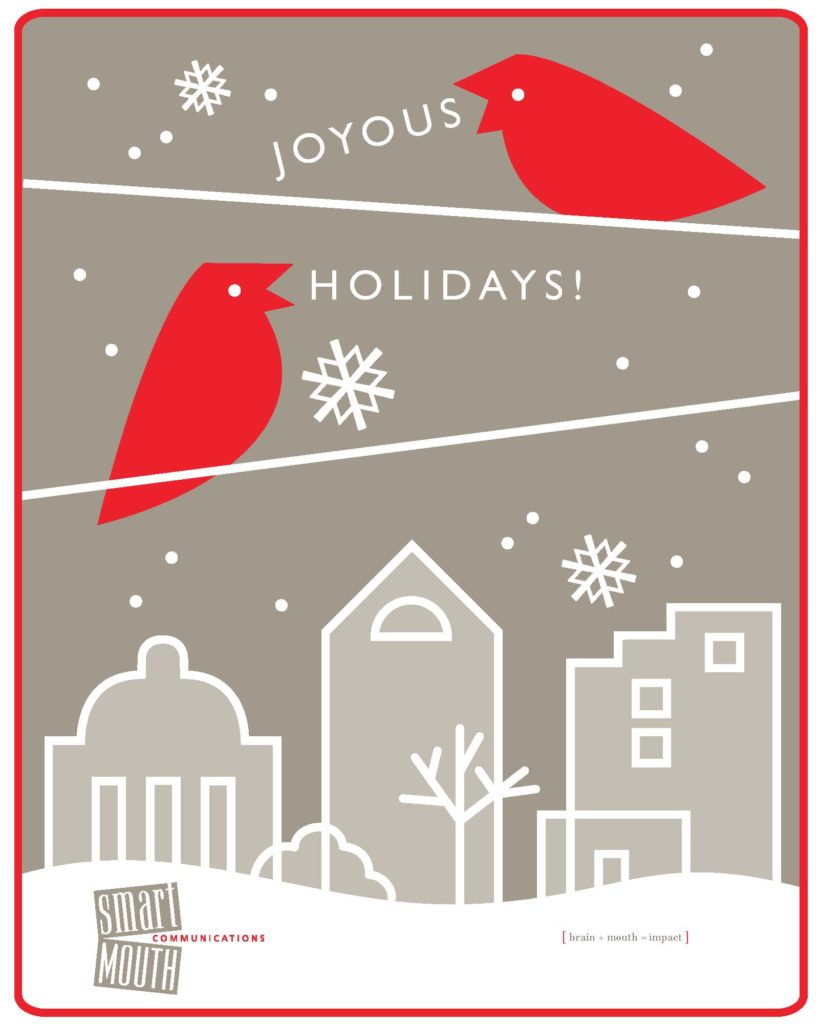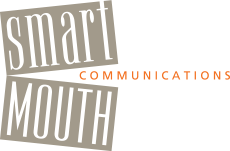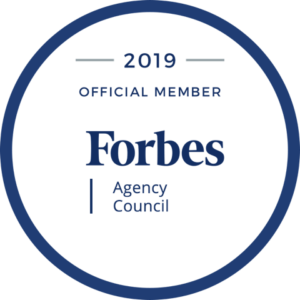SmartMouth Talks!
Since when?
 Since when did the word “presentation” become synonymous with PowerPoint? Why is it there’s an automatic assumption when you walk into a room to talk — even to only 10 people and even for only 10 or 20 minutes – that you will use slides? In fact, the screen awaits you, and your host tells you where and how to hook up your laptop without ever having asked you in advance.
Since when did the word “presentation” become synonymous with PowerPoint? Why is it there’s an automatic assumption when you walk into a room to talk — even to only 10 people and even for only 10 or 20 minutes – that you will use slides? In fact, the screen awaits you, and your host tells you where and how to hook up your laptop without ever having asked you in advance.
Yet if you were to poll the people in the room (and I always do!), they are most often 100% unanimous in saying they strongly dislike PowerPoint and prefer that you not use it. This is due to the overuse and misuse of PowerPoint – which, ironically, is due to the automatic assumption that you’re going to, which is due to the fact that “presentation” has become synonymous with PowerPoint.
As a longtime whiteboard user (I draw a lot of pictures and write out words and phrases when talking to groups), I have spent many years gloating over my informal poll results that reveal universal disdain for PowerPoint. After all, my stick figure drawings and primitive renderings of houses, fish, and bullseyes are more clever and amusing than some slick PPT template, right?!
Right in only one way: Audiences do tend to remember and retain visuals better when they watch them come alive so to speak. Well, and maybe they’re also a little bit amusing.
But wrong in other ways.
Last week, after a whiteboard talk and one of my informal polls – “By a show of hands, how many of you wish I had used PowerPoint?” Total hands raised: 0 – the audience groaned and moaned about how useless PowerPoint is and how glad they were that I didn’t turn down the lights and make them stare at a screen.
And then it happened. I found myself defending PowerPoint as an incredibly useful tool. “It’s not dreadful, it’s a fantastic visual aid,” I implored, “and most people are visual learners and need visual reinforcement.” All true.
I went on to point out that what is dreadful is how people use PowerPoint, which is as a script or as a substitute for a handout (suffice it to say, you know what and who I’m talking about). Slides dense with words are the worst, but the list of offenses committed via PowerPoint is endless.
Personally, I think this is a Monkey-See-Monkey-Do issue. People follow the model of what they’ve seen before and with 30 million PowerPoint presentations per day in the U.S. (that’s according to the Wall Street Journal), you can see how bad habits might form by mindlessly following others. People just need permission to approach PowerPoint differently.
So here are 6 permissions I will give you:
- You may use one word on a slide. Large font, centered.
- You may use an image or a graphic with no words. You will provide the words and the meaning as you talk.
- You may even use a spreadsheet but only if you enlarge or circle in a very bright color the number(s) or section you will be talking about.
- You may have only a few, versus a few hundred, slides.
- You may show your dog, or an image of yourself skiing.
- You may prepare your PowerPoint after you’ve organized your thoughts and decided what you’re going to say, if you have time, and if you don’t have time, use a white board.
These are just a start, but feel free to go outside the box of what you’ve seen others do. Just keep in mind these two words: visual reinforcement. Explanation and narration come from the presenter.
Welcome to the Big Leagues
The other day, as I was wrapping up part two of a three-part presentation skills training program, I gave the group their assignment for the mock presentations they are scheduled to deliver during the third and final phase. I think it’s fair to say that the 18 or so faces in front of me did not look excited, so I found myself saying: “Please don’t dread these presentations. They’re going to be much more fun and beneficial than you think. Look at them as an opportunity, a gift … yada yada yada.”
Ugh, since when did I become just like the dentist? That’s what the faces seemed to convey to me – the upcoming mock presentations evoked the same dread as impending dental work.
The reality for this group, however, is that being given the chance to work on their presentation skills in a safe, friendly, supportive environment is an opportunity and a gift. They are part of a leadership development program in their company and therefore have been identified as super high-potential professionals deemed worthy of the investment of time and money. Their skills are being cultivated in many areas critical to their future success, presentation skills being just one.
If I had been thinking on my feet a little better that day, I would not have said, “Please don’t dread these presentations.” Here’s what I would have said instead and here’s what everyone in a high-potential career situation needs to think about:
 “Welcome to the big leagues! In the big leagues, you guys will go up against some of the best in the business, and there is no doubt your communication and presentation skills will be one of your key differentiators. So, let’s talk about you getting in the right head space for this next and final phase of our training.
“Welcome to the big leagues! In the big leagues, you guys will go up against some of the best in the business, and there is no doubt your communication and presentation skills will be one of your key differentiators. So, let’s talk about you getting in the right head space for this next and final phase of our training.
No one in the big leagues wastes time dreading an at bat. Rather, they spend their time imagining a home run, being fully prepared to deliver a stellar performance, and embracing the moment when it comes. That’s what I want all of you to do as you get ready for your presentations – imagine success, prepare for it, and come into the room like it’s Opening Day and you are being given an opportunity to shine!”
That would have been a heck of a lot better than imploring the group not to dread it. Lesson learned … by me, this time!
282 Words
Universal experience: You patiently sit through a talk in which the speaker drones on for 30 minutes just to make a point that clearly could have been made in five.
 Arrrrggggh, frustrating! You feel like your precious time was wasted. And that’s because your time was, in fact, wasted. This is where phrases like, “well that’s an hour of my life I’ll never get back” come from.
Arrrrggggh, frustrating! You feel like your precious time was wasted. And that’s because your time was, in fact, wasted. This is where phrases like, “well that’s an hour of my life I’ll never get back” come from.
And this is why brevity is one of SmartMouth’s 5 communication principles for leaders.
If you’re a speaker or presenter, consider this: You want to be that person, the one who is able to be concise and impactful. Being brief is the fastest and best route to being memorable and impressive.
Brevity is cultivated, and here’s what it’s all about:
-
It’s about planning and preparation – yep, knowing how you’re going to open, what your main points are, and where you want to take your audience so you can do it efficiently.
-
It’s about rehearsal – yep, and by rehearsal, I mean talking out loud so you can hear for yourself where you need to clarify, cut, or refine transitions.
-
It’s about respecting the unspoken agreement between you and your audience that you’ll use their time wisely and deliver value to them.
-
It’s about respecting the agreed-upon time limits you were given.
-
It’s about avoiding TMI and limiting your information dump to only those things that will be interesting to your audience (and not just to you).
#Protip #1: Ask yourself whether your audience is in the room by choice or by obligation. If it’s by obligation, do everyone a favor and be brief!
#Protip #2: Brevity trumps comprehensiveness 99.9% of the time!
Up to this point, I have made my point in 282 words (only 10 more words than the Gettysburg Address). Hopefully, it’s short enough to hold your attention and long enough to leave you with valuable food for thought!
Know your audience. Ok, but how?
Know your audience. You’ve heard this bit of presentation advice before, right?

At SmartMouth, we talk a lot about #audience-centricity. It’s a pretty simple concept: focus on your audience and consider things from their perspective. It’s our more specific version of know your audience.
But we probably don’t talk enough about how to know your audience and what to do if they’re a diverse group and want/need different things.
Let’s explore how to know your audience – especially when you don’t actually know them – from these 4 different angles:
1. First, ask, look and listen (our version of stop, drop and roll, if you will). Ask whoever is coordinating the meeting or event about the audience; find out what they know about the audience’s expectations, wants and needs. Do some research on your audience’s industry or organization so you know their issues and priorities (this is where Google really earns its stripes!). Then use what you learned – in other words, be sure to assimilate the intelligence you gather into your presentation.
2. Second, there are some audiences who come into the room with glaringly different interests, some audiences with a single common interest, and some that fall in between. You’re all set with the ones who have a common interest, no worries there. But when you know ahead of time that members of your audience are coming into the room with varying levels of receptiveness or knowledge about your topic – e.g. some hostile/some friendly or some well-versed/some newbies – then you’ve got a challenge on your hands. This is where #transparency will give you a boost!
By telling you to be transparent, I’m recommending that you call it out. Let the audience know you know (that there’s a challenging dynamic in the room) so they don’t have to worry whether you know or, worse, think you’re disconnected. For example, you might open with: “I’m looking forward to talking today about XYZ Initiative. I know this is a project that brings strong supporters and equally strong detractors into the room. My hope is that after my update, we can have a productive, constructive dialogue, honor each other’s opinions, and leave the room feeling like things are on track and everyone’s concerns will be taken into consideration.”
Or: “I’m looking forward to talking today about XYZ Initiative. I know this is a project that some of you are up to speed on and some of you are hearing about for the first time. I will do my best to strike a balance while I present this update. As I go through the material, I’m going to ask for patience from those of you already high on the learning curve, and I’m going to invite questions from those of you who are new to this. By the end, I’m hoping we can have a robust, productive dialogue about the project.”
3. Third, engage them, ask them questions. Dip into the audience for input. If your audience is of a manageable size and you haven’t had an opportunity, for whatever reason, to “ask, look and listen” before entering the room, ask, look and listen when you’re in the room. For example, even when I know my audience, I will often introduce my topic and then solicit the audience’s “goals” around the topic – i.e. questions, concerns, issues on their minds related to the topic. This gives me more specific insight into what’s in it for them and where I might want to adapt or adjust my presentation. The added benefit is that they feel heard, recognized and hopefully, by the end, satisfied.
4. Fourth, there are certain general things that almost every audience wants whether you know them or not. They want you to keep to the allotted time or (let’s face it, even better) to finish early. They want a presenter who is prepared versus one who is noticeably disjointed and delivering on the fly (your audience doesn’t want to be your sounding board, they want to be the real deal). They want to be noticed and included; they want you to acknowledge them, engage with them, be present with them.
In the end, it really comes down to moving yourself toward being audience-centric versus egocentric. Yes, you have an agenda and cool stuff to share. But your audience also has an agenda. And since success is in the eyes of the beholder – your audience – you’ll want to be sure to skew your presentation toward satisfying their agenda. If you’re able to do that, I’m going to bet you end up satisfying your own too.
Feel free to comment on this or reach out with a question, I’m always happy to discuss further or to help!
Communication Tip #1,374
Communication tip #1,374 is this: Stop talking and start listening.
Communicating is a two-way street, a two-party system, so to speak. Yet in most discussions about communication skills, a disproportionate amount of time and focus (granted, I am guilty of this as well!) is spent on the output side. The input, or intake, side gets less attention.

What we’re talking about here is listening. Yup, we’re talking about communicating’s better half – the listening side of the equation. If you’re the speaker at a meeting or presentation, there’s a danger of preparing to “broadcast” but that’s only one half of your work at the front of the room.
Here are 3 tips on listening:
1. Employ what I like to call dynamic listening – listening with all of your senses, and listening before, during and after your meeting or presentation. In a nutshell: Listen, or pay attention, to your audience with not only your ears, but your eyes, your gut and intuition. And listen not only during your meeting or presentation, but before and after – by anticipating before and reflecting after. The goal here is to meet your audience’s needs, satisfy their interests, and create the best possible experience for them.
2. Especially during Q&A, listen for themes that reveal concerns and interests, rather than listening to specific words. Other people’s words can derail you, get you off message, and – the worst – potentially draw you into negative language. If you listen for the theme of someone’s question (or soapbox speech, which is okay too!), you will be more apt and able to take command of the reply and answer using your own positive, affirmative words as opposed to rehashing someone else’s potentially negative words.
3. For your own benefit and the benefit of the other person/people you are communicating with, use the therapists’ tried-and-true technique of active listening. Active listening involves fully listening for comprehension and restating back to a person what you understood their statement or question to be. This helps both parties in the communication. The speaker consciously listens in order to be able to repeat for confirmation – which aids their retention and comprehension. And the person who made the comment or asked the question feels heard and cared about – plus they have the opportunity to correct or adjust their point if it was misstated.
At the end of the day, it’s all about them – your audience – and not all about you. Therefore, the two sides of the communication coin are equally important in delivering a positive experience and good impression to your audiences.
Listen up and good luck out there!
Check Your Presence
Executive presence is a thing.

I’m going to take an alternative view here today and offer up a one-word answer to the executive presence conundrum: presence. Yup, presence. The executive presence challenge can be conquered largely with presence. And by that, I mean being present.
Let me explain what I mean. I think it’s fair to say that a lot of aspiring ambitious professionals care very much about how they appear and what others – especially their superiors – think of them. I think it’s also fair to say that these same professionals are pretty concerned – perhaps even consumed – with wanting to sound smart when they open their mouths. So who are they thinking about when they’re in an important meeting or about to deliver a presentation? Who are they (mentally) connecting with in the room? You got it … themselves. And what effect do you think that might have on their executive presence? You got it … a diminishing effect.
Being present isn’t just a new-agey self-helpy thing – not that there’s anything wrong with that! It’s a business thing too. Presence is a state of mind, a willingness to subdue other thoughts and distractions for the sake of literally being with what’s right in front of you at any given moment. It’s an ease and a fluidity of motion, contact and conversation with the people, issues and ideas in front of you. It’s shelving those pesky, nagging self-conscious thoughts in favor of being available, accessible and real.
Let’s face it, preoccupation with yourself – worrying about your appearance and your slides/script – can result in a more detached and, for some, robotic presence, causing you to leave a dampened, diminished impression with your audience. But preoccupation with your audience – demonstrating a genuine desire to connect and be with them – is likely to result in you leaving a positive, memorable impression.
Executive presence doesn’t have to be some pre-conceived picture of a perfectly poised, poetically articulate version of you. It can come simply from the ease and the authenticity of your engagement with others. Your executive presence can come from your presence. Try it!
Open Letter to Coach B
Dear Coach Belichick,

Yeah, it’s kind of fun and funny to watch how you grunt out one-word answers as you oblige the press in your charmingly begrudging way. And yeah, the hoodie and messy hair are also part of your charm. And yeah, your annoyance with reporters’ stupid questions is our annoyance too. And for sure, you are an amazing coach, you’ll go down as one of the greats. No question there.
But.
Before Sunday, can we talk about what it would/could look like, sound like, and be like if you gave them (the sports media) and us (your fans and followers) a little bit more? Could I be so bold as to offer you some coaching?
Here are just a couple of suggestions for you that would enhance the overall post-game interview experience and outcome for everyone:
- Never mind the media, they’re just a conduit to your bigger audience. Show up in a way that tells us you want to connect with us. We love your #brevity, but with all due respect to dentists, don’t show up looking like you’re about to have all your teeth pulled. We feel a little jilted when you do that.
- Think about your audience, your ultimate audience – us, your fans and followers. We’re hungry, thirsty, sometimes crazed. Satisfy us, give us something to hold onto, something we can cling to, learn from, and/or repeat to others. #audience-centricity goes a long way toward keeping your fan base engaged and pulling for you.
- Win or lose, the emotions are intense. We get that. We have empathy, we’d hug you if we could. Share your emotions with us, let us in, give us a sense of what it’s like to walk around in your hoodie, cleats and headset. Please recognize we’re emotional too, but you’re our leader, and we will take our cues from you. Let us in a little more, give us more #transparency?
- We know you have haters, we get it. And we know the media can distort what you say and how you say it. But you’re one of the greats, surely you can rise above and give us all the #graciousness you have. Your loyalists want to be behind a winner, no matter what the outcome of the game is.
- You have a Super Bowl to win, so your #preparedness needs to be about strategy for game day and not necessarily about how you present yourself in front of the press. I’ll give you that. But I know you’re a pro, so when the game is over see what you can do to hit some or all of the above four points.
Hey, thanks for your time and good luck on Sunday!
Your coach,
Beth #jocktalkbook
For Real
Be yourself. For real. I mean it.

Let me explain why and hopefully relieve you from any conscious or subconscious thoughts about needing to be more or better than what you already are:
Authenticity. This is more than a buzzword. Your authenticity is what draws people to you, makes you likeable and credible. This is what you abandon, betray even, when you try to adopt a podium persona. On the one hand, authenticity reveals you; in the best sense, it shows your great traits, but then, yes, it possibly shows some of your not so great traits as well. On the other hand, authenticity shares you, it makes you real and relatable. Allowing oneself to be real and relatable is ultimately what makes a speaker compelling and appealing and effective.
Transparency. We live in a world where there are very few secrets. People can see and find out more about each other now than even five or 10 years ago. People share and post more about themselves now than they ever did. The net result from both sides of this equation is that audiences have a keen sense of what’s real and what’s not and so they can be quite skeptical and discerning. Audiences can sniff out BS these days faster than you can advance a slide. Just like authenticity, transparency can enhance your likeability and credibility. Being open, especially when it’s difficult or unexpected, will earn you points with audiences.
Good enough. The real you is good enough. Could you be better, more organized, more polished as a speaker? Sure, everyone can be. Should that stop you from getting up and speaking with confidence? No. You’re an adult, a professional, and you’re respected enough to be asked or invited to go the podium and speak. Embrace who you know you are – the good parts and the parts that are works in progress – and acknowledge to yourself that, though you may not be as great as you’d ideally like to be, you are pretty darn good, certainly good enough. And let that be the last thought you have before you approach the microphone!
Your First Presentation of the Year

Most of us hit a personal reset button or two on the 1st of January. But even if you aren’t someone who makes specific resolutions, you probably still view the new year as a blank slate, a chance to start fresh.
Let me help you get off to a fresh start for your first presentation of the year by offering a SmartMouth Top 10 list on this first Wednesday of 2017:
10. You know this: Do your homework. Nothing drastic, just prepare ahead. If you think through your material rather than wing it, it will show and reflect well on you.
9. There’s no right or wrong, but there is better and worse. When in doubt, make decisions about your content, your visuals and the amount of time you’ll take based on your own experiences as an audience member. In other words, do unto others …
8. No one likes a windbag. Share the floor. Figure out ways to engage your audience and create opportunities for dialogue. Present, don’t broadcast.
7. Whatever you think is noticeable and distracting about you – your voice, hair, nose – it’s not. Unless you’re a paid spokesmodel, the audience isn’t paying attention to your specific physical features or your voice quality. They want to feel your confidence and hear your content.
6. Your content may be amazing, but your audience can only digest and retain some of it. Please prioritize all that great knowledge and information of yours so that you deliver something useful and memorable to your audience.
5. Present, the verb: to give something. Present, the noun: a gift. Figure out what you can give to your audience that would be a good gift – i.e. something new, useful, beneficial, valuable. Give them something good in exchange for their time and attention.
4. Your nerves are just adrenaline. They are your body’s way of surging positive energy for you to do a good job. Not to worry, studies show that nerves begin to dissipate after two minutes – that’s only 120 seconds.
3. Don’t dread your presentation, as if it’s some unpleasant obligation. Find your ambitious self and embrace your presentation as a great opportunity to advance – yourself, your organization or a goal. Go for it, don’t shrink from it.
2. Be organized: know your audience, know the lay of the land (number of people, room set-up, mic or no mic) as best you can, and know your desired outcome for the presentation. The first two help you envision what to expect. The third helps you know – if you prepare nothing else – how to set the audience’s expectations and where you need to get them by the end.
– and –
1. It’s all about them, it’s not about you. Your audience’s needs and experience supersede your own. Plan your presentation around them, not around yourself or your deep knowledge and expertise. Success is in the eye of the beholder, and that’s your audience. Make them #1.
Messaging for the Season
Best wishes for a happy holiday season and a healthy, prosperous New Year!




